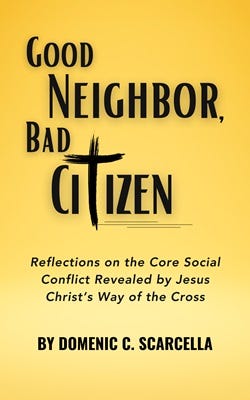Food & Holidays: Not-So-Strange ‘Breadfellows’
The Feast of St. Joseph Shows an Ancient Connection That’s Baked Into Our Language
If you enjoy this article, please click Like (❤️) to help others find my work.

News of the bakery opening spread like jelly in a doughnut (I don’t care if that’s a lousy simile; I like jelly doughnuts).
The hip, stylish town up the road hasn’t had an old-fashioned retail bakery in a few years, not since the satellite retail store of an industrial wholesale bakery closed. A developer had acquired the land to construct an ultra-modern warehouse of self-storage lockers. As a minimalist who likes jelly doughnuts (see first paragraph), I did not consider this to be progress.
So when the industrial wholesale bakery — which has had its factory headquarters in the town for ages — purchased and began renovating an old empty grocery store on the main road, many ears and taste buds perked up.
I wondered if the new bakery and large retail store with many specialty products would be ready to open by today, March 19.
Why this date? The bakery is Italian, and March 19 is the Feast of St. Joseph. The holiday began centuries ago in Sicily, Italy, and has become known in the modern era for its zeppoli and sfinci styles of filled pastries.
I’ve written previously about St. Joseph, the man (“St. Joseph & the Virtue of Disobedience”). In today’s article, I hope you’ll enjoy exploring the origins of the holiday attributed to him, and what food means to our social fabric.
‘Consumer’ culture
Foods are very much connected to holidays and the people with whom we share them.
The stories behind the foods can help remind us of the origins and meaning of the celebrations. Other times, the understanding and emphasis change so much that it seems like an entirely different holiday than what it used to be. But even if the origin stories fall out of favor, the ties to food remain.

Two days before St. Joseph’s Day, for example, St. Patrick’s Day has its origins in the life of a man named Patrick, his escape from slavery, and his return to Ireland as a bishop in the 5th Century. In the U.S., St. Patrick’s Day became mostly about Irish ethnicity and the common foods associated with the poor Irish immigrants (cabbage, soda bread, etc.). For too many, it has deteriorated into an unfortunate stereotype of the Irish as heavy alcohol drinkers.
The previous month’s Valentine’s Day is now known for romantic love and the sweet treats that call to mind the “sweethearts” that many seek to share such affections and confections. How many know the subversive roots of St. Valentine’s Day and the Early Church?
Even secular holidays are now mostly about the leisurely enjoyment of food, too often setting aside the deeper meaning.
Thanksgiving, for many, is most anticipated for the turkey, comfort-food side dishes, and dessert pies. Does it matter why those first Thanksgiving celebrants were so thankful in whatever-that-year-was in whatever-that-place-was?
Independence Day is now about summer cookouts and fireworks. Ironically, it’s also about “patriotic” worship of government and pledging allegiance to its flag. How’s THAT for revisionist history!
‘With bread’
St. Joseph’s Day is different in that it began with food! A writer and professional baker, Kevin Di Camillo, explained the history and many of the foods associated with the day of grateful celebration. From his essay:
Legends from the Middle Ages attributed the end of a devastating drought to a prayer-devotion that the Sicilian people made to St. Joseph. This celebration is a symbolic “thank you” and renewal of the Sicilian people’s devotion to St. Joseph. It is a shared celebration with the entire community where the riches of food are given as alms to the poor: Traditional etiquette is that no one can be turned away from this table.
Above all, the holiday originated as one of sharing, and the connection to breads (even the sweet ones like zeppoli and sfinci) recalls an ancient understanding about food and social relationships.

The words “company” and “companion” harken back to the importance of sharing bread with those we love, and how the act of eating a meal with people can engender good feelings and make friends out of strangers. The words combine the Latin roots:
com (meaning “with” or “together”),
panis (meaning “bread”).
Company/companions are literally those who have bread together. They’re your “breadfellows,” so to speak.
Sharing bread is an act between peers. And treating others as peers — neighbors — is essential to forming connections based on human dignity and consent. In societies saturated with imposed, hierarchical social order, it can be a subversive act!
The anarchist/voluntarist Early Church, for instance, called their most important sacrament the “Breaking of the Bread” (Acts 2:42 & 20:7, among other New Testament references), which replaced and subverted all other public loyalty oaths (“meat sacrifice to idols”; Acts 15:29).
It was — and still is for those who celebrate what’s now commonly called “Eucharist” (the sacrifice of “thanksgiving” in Greek) — an efficacious sign of both communion with God and shared faith with fellow believers.
As for the local bakery I hoped would be welcoming customers this week, it won’t open until later this Spring, maybe. It’s too bad, as I bet plenty of good company would’ve turned out for a zeppoli-laden debut on the feast day!
If you’re able to source freshly made St. Joseph’s Day fare this week, I hope you enjoy the edible excursion. I also hope you gain an appreciation for the connection between food and fellowship underpinning the charitable holiday.
And if you can find it in your heart, share some of your good cheer and good fortune with others. It’s the good-neighbor thing to do.
Share your thoughts, too …
… in the Comments section!
We may not literally break bread with each other, but I appreciate all of you who take the time to post your ideas, questions, and reactions to my assorted ramblings here. We make good company, even if we only meet online!
Let me know what’s on your mind …
—
Want some extra spiritual reading for Lent? I suggest the book, Good Neighbor, Bad Citizen, available at:
Amazon (paperback & Kindle)
Barnes&Noble (paperback)
Lulu (paperback)
Find me on X: GoodNeighBadCit
And, as always: Be a good neighbor, even if it makes you a bad citizen.





My maternal grandmother was Josephine, named after the Saint's day of her birth, as was often the custom then.
Com panis- cool.